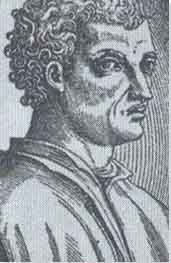Summary of Leon Battista Alberti
Alberti is considered the father of Early Renaissance art theory and, because of his great adaptability, the archetypal "universal man". He is perhaps revered first-and-foremost as the founder of modern architecture. But Alberti's faith in mathematical principles and rational order led him into overlapping fields ranging through science, art, philosophy, cosmography, cryptology and modern and classical languages.
Drawing inspiration from the ancient civilizations (not to mention fellow architect Filippo Brunelleschi) his ideas were put into writing through several groundbreaking treatises that had the most profound and lasting effect on Early Renaissance art and architecture. In the field of painting, his ideas on perspective provided the groundwork for two next generation Renaissance giants, Piero della Francesca and Leonardo da Vinci.
Accomplishments
- Alberti's contribution to painting, architecture and sculpture was cemented with his three groundbreaking treatises, respectively: De pittura (1435), De re aedificatoria (1452) and De statua (1568). These textbooks would constitute the very core of the Florentine Renaissance and provided it with the rules of scientific and mathematical balance on which a new age in art and art theory was built.
- It was principally through his love of Roman arches and columns that Alberti distinguished himself from his peers and confirmed the importance of antiquity to the outstanding aesthetic quality of Renaissance architecture. Advances in building meant that these features no longer served a vital supporting or structural function, but the beauty and balance of their design helped humanize the churches, palaces and palazzos which they graced.
- As the originator of pictorial perspective, Alberti can be credited as the first to propose a set of principles by which artists could authenticate their narratives and vistas against an agreed set of compositional rules. The laws of pictorial perspective and verisimilitude became institutionalized and have been passed down through the Academies that spread throughout Europe and America in the subsequent centuries.
- Although Alberti is best known for his treatises and his architectural designs, he is also credited with being the first to produce a self-portrait. He did this in the form of a medallion to which he also introduced the feature of the symbolic emblem. Alberti had effectively revised the designs and symbols of antiquity (Roman cameos and Egyptian hieroglyphics in his case), and thus pointed the way forward for the royal and scholarly portrait medals that would follow.
The Life of Leon Battista Alberti
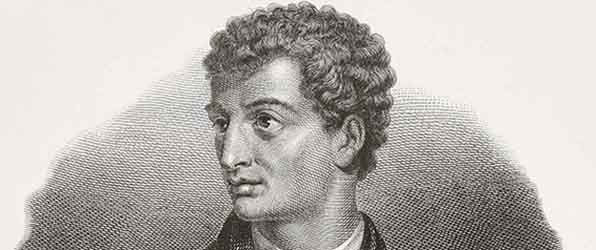
Alberti, for whom Beauty was "the adjustment of all parts proportionately", manifested itself only in works "that one cannot add or subtract or change without impairing the harmony of the whole".
Important Art by Leon Battista Alberti
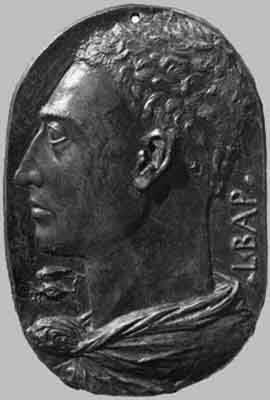
Self-Portrait
While Alberti's impact on the art world was recognized in his own lifetime, he chose to memorialise his own image before he reached the full heights of his fame. This might account for this relatively modest (in size) medallion that measures just a little over seven by five inches. It stands, nevertheless, as an important "first" in the Italian master's impressive oeuvre.
Alberti's oval relief acknowledges the legacy of classical culture in its close resemblance to a cameo. Impressively detailed, however, historian Anthony Grafton describes how the piece "shows its maker with all the energy of early middle age, with a powerful profile and strongly marked, determined eyes and mouth". He is, Grafton continues, "Classically dressed [and] clearly makes a claim to high social and intellectual status". Most historians have been drawn to presence of the Alberti emblem that takes the form of a winged eye (that accompanies "L. BAP": his first initial and the first three letters of his second name). Ancient Egyptian civilization fascinated many humanists and, as the Washington National Gallery of Art observes, Alberti's emblem was probably intended to "refer to the all-seeing eye of God, to the primacy of the eye for human inquiry, and even to Egyptian hieroglyphics".
While Alberti was remembered for many things, perhaps most notably his writings and his building designs, this piece offers abundant proof of Alberti's skill as an artist and his admiration for the ages of antiquity. In describing the impact of this piece, for instance, Grafton states, "it is, in many ways, a remarkable artistic achievement: the first free-standing self-portrait by a Renaissance artist, the first to clothe the artist as a Roman, and an image far more individual than many portraits by the advanced artists of the time". It also provided a model for future medallions and, as Grafton adds, "clearly anticipated, and may have served as a source for, the portrait medals of princes and scholars that two professional artists he knew well, Pisanello and Matteo de'Pasti, would produce in the 1440s and 1450s".
Bronze - Collection of National Gallery of Art, Washington DC
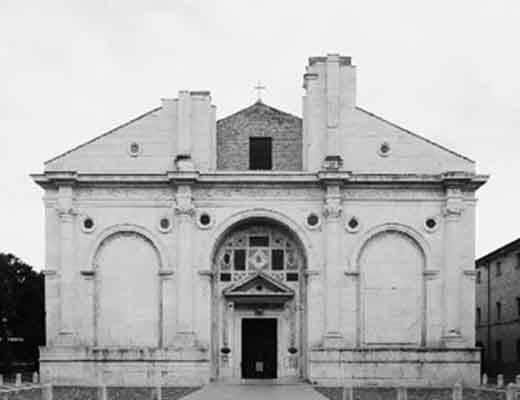
Tempio Malatestiano
Alberti received the commission to design the Tempio Malatestiano from nobleman Sigismondo Pandolfo Malatesta who intended it to serve as a mausoleum and testament to his love for his future wife, Isotta degli Atti. Alberti did not have to start the project from scratch, however, and instead redesigned the exterior of an existing 13th century Gothic church. His new façade, featured what would become a trademark for Alberti's architectural works: the revival of the Roman arch. As historian Joan Gadol describes, "the three arches of the main story of its façade and the arch of its (incomplete) upper story are arranged like the three doorways and rose window of the typical Gothic façade, marking on the walled exterior of the church the interior relation of nave to aisles. But the form of the arches Alberti so disposed is that of the rounded triumphal arch; and the relation of aisles to nave, and of main story to upper one, which the classical arch expresses is reinforced by his use of the Corinthian column and architrave".
This is the first church design Alberti created. A great achievement, according to Gadol, "the building established Alberti as a major architect, a worthy successor of his friend, Brunelleschi [and] making Alberti the mediator between the quattrocento [fourteenth century] master and the architecture of the High Renaissance". In this work, Alberti began his quest to define what Renaissance architecture should be; a quest he would memorialize in print two years later in his publication De re aedificatoria (On the Art of Building). This structure provides the first architectural example of how mathematics and art were inextricable bound to his thinking. The famous Renaissance biographer Giorgio Vasari called the building a "stunning achievement" and commented that Alberti's facade represented such "fine workmanship" it had transformed the original edifice into "one of the most famous churches in Italy".
Rimini, Italy
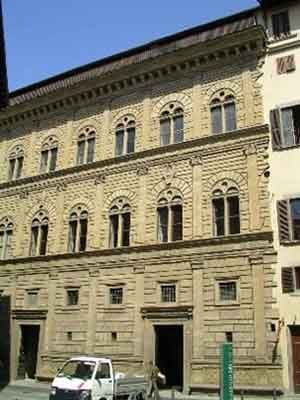
Palazzo Rucellai
A private residence, Alberti designed this home for his friend and patron, the renowned merchant, Giovanni Rucellai. Visually engaging, it is composed of three tiers which decrease in height as one's gaze moves upward. Alberti distinguished himself from his contemporaries in his reliance on antiquity for inspiration; using Roman inspired arches around and columns positioned on either side of the windows and doorways of the building.
These Roman elements - the star of Alberti's façade - make a quite deliberate reference to the importance of antiquity in Renaissance art and design. However, while the arches and columns were often structural necessities in Roman days, here Alberti's inclusion of these elements are essentially decorative. In designing a palazzo in this way, Gadol states that Alberti "humanized and civilized this harsh, militant genre to a remarkable degree. Using flat masonry planes with bevelled edges, Alberti smoothed out the rugged rustication of the Florentine palace". Alberti's fresh take on exteriors would begin to be incorporated in other palazzo façade designs. For Gadol, there is no purpose beyond the ornamental, but "in this aesthetic sense, however, they serve a genuinely architectonic purpose, for the orders make a proportionally articulated whole out of the building's façade". It was for Gadol, "Alberti's most graceful work [that] belongs nowhere else in the world but in Florence".
Palazzo Rucellai, Florence
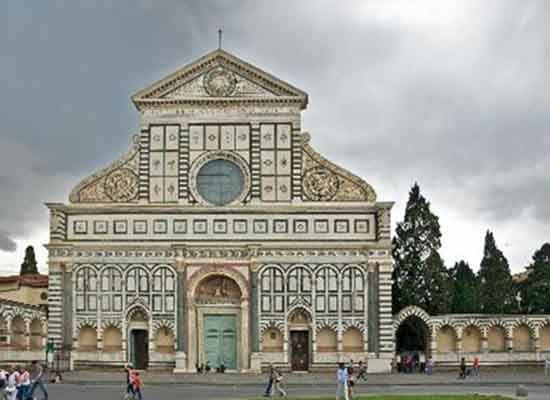
Santa Maria Novella
A beautifully detailed and ornate structure, Alberti's façade of the Florentine Santa Maria Novella church is a visualization of his definition of ecclesiastical design, and one for which he again drew on the past. According to Gadol, "the formal relations among what would seem to be the jarring elements of three different styles, Romanesque, Gothic, and classical, produce Alberti's unmistakable kind of unity [...] By adding the four great Corinthian half-columns to the lower story, and four stripped pilasters to the upper, Alberti broke up the wall of the façade into the distinct areas which he then related rhythmically to each other". Gadol also remarked on the "horizontal demarcation" which was carried out "by the broad attic between the two stories, and by the entablatures that run above the columns of the main story and pilasters of the upper one". For Gadol, moreover, "The pediment is the final horizontal touch" since it "lifts the upper story, and it creates the impression of the three matching imaginary squares of the front: the two 'squares' into which the main story can be divided, and the 'square' of the upper story between the two decorative scrolls [and with] all these areas defined, the proportional rhythm of the entire façade could come to life".
Alberti designed this structure for his patron, the merchant Giovanni Rucellai, and was his first major project since the 1452 publication of his seminal treatise on building, De re aedificatoria (On the Art of Building). Only his second church façade, one can see how far he had come in perfecting his vision from his design for the Tempio Malatestiano six years earlier. Unlike the previous work, however, here Alberti allowed himself to pay tribute to the great works of antiquity beyond the arches and columns by focusing on ornament and design elements on the church's exterior.
The critic Flavia De Marco writes that Alberti's "ideal execution of buildings is based on the concept of concinnitas - a harmony regulator among the ancient and omnipresent basis in nature [...] The lower part showed a 14th century realization that Alberti had to harmonize with the new fifteenth schemes. The result is an eternal partnership between ancient and modern; local materials, the Carrara marble, and some original and naturalistic ornaments; everything rigorously studied according to the mathematical proportions so that, even today, we remain still in awe in front of such majesty, elegance and creativity".
Florence, Italy
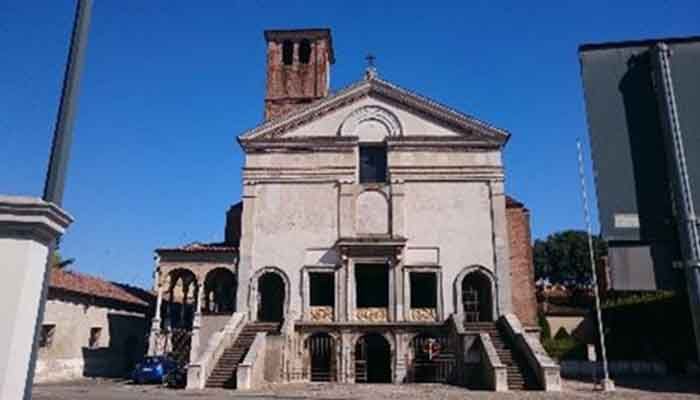
San Sebastiano
Alberti's design for the façade of the church of San Sebastiano is less ornate than some of his earlier ecclesiastical designs. Still, it displays many characteristics of his style including decorative columns, a beautiful overall structural symmetry and rounded arches above the doorways that repeat at the top of the structure's pediment. Alberti received the commission for this church from one of his last great patrons, Ludovico Gonzaga. According to historian Anthony Grafton, "by the 1470s, Alberti enjoyed a unique status in Ludovico's eyes [and his] patron defended his architect against all critics".
While Alberti did not oversee any aspect of the building of his structures - De Marco referred to him in fact as a "Ghost Architect" who "Probably due to his intellectual character [...] had never set a foot on the yards of his projects [and followed] the work remotely through precise correspondence exchanged with the chosen foreman" - he nevertheless demonstrated a strong engineering vision in his plans and often had to make changes as problems arose. As Grafton explains, "in rearing San Sebastiano in Mantua, he found that water rose through the walls by capillary action from the ground under the church, permeating the structure with so much dampness that he had to alter his original plan radically, inserting a crypt with windows to allow air to circulate and help the building dry out".
While the church's façade is its most striking feature, the rest of Alberti's plans for the church were not implemented. Work on the project slowed over the course of several years (after construction began in 1460) and Alberti died before it was finished (leaving others to work on the interior design). San Sebastiano pre-empts Alberti's second commission for Gonzaga, the design for the Church of Sant'Andrea (1472), the latter coming much closer to a complete Alberti project.
Mantua, Italy
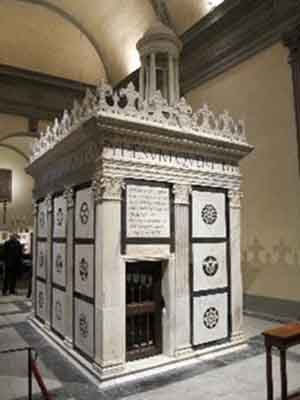
Rucellai Sepulchre
The smallest of Alberti's architectural works, this tomb was commissioned by his patron Giovanni Rucellai. Located in what was the church of San Pancrazio in Florence (now the Museo Marino Marini). The Roman Anglican website describes how the tomb, "is a scale reproduction of the [Church of the] Holy Sepulchre in Jerusalem, except obviously for the exterior decoration which is an interpretation on earlier Florentine Medieval and Classical styles [...] Alberti modernized and revalued these themes [...] The upper part is decorated with fleur-de-lys shaped merlons, the theme is in honour of the Blessed Virgin Mary of the Annunciation to whom the Chapel was originally dedicated".
Alberti was not deterred by the challenge of having never seen the church on which the tomb was to be modelled. According to Grafton, "Alberti presumably drew on pilgrims' reports and drawings when he laid the building out and equipped it with its curious, off-center canopy. But the larger design he followed for the façade of the little structure [...] was his own choice, not dictated by neighboring buildings or required by the function of his own new construction". The author Annelise Ream, adds that "Alberti believed it was important to use ratio as a way to express cosmic harmony through the proportions and design of a structure [and here] the marble designs upon its exterior, are carefully planned according to these theories. The designs of the 30 marble inlaid squares that adorn the exterior walls [...] reference organic symbols such as leaves of laurel and oak, as well as geometric forms such as the eight and six-pointed star. The center square panel of each wall features designs that represent the emblems of the families related to the Rucellai, notably the Medici".
Florence, Italy
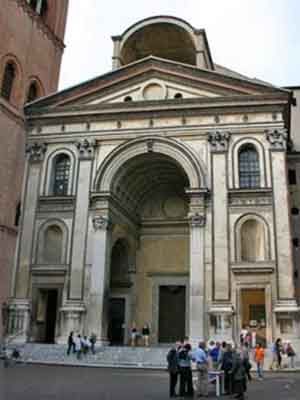
Church of Sant'Andrea
Alberti received the commission to design the Church of Sant'Andrea from his patron Lodovico Gonzaga, the ruler of the Italian city of Mantua. Characteristically, the star of Alberti's design was the Roman-inspired arch which dominates the church's entranceway. In a design of perfect symmetry, as Gadol explains, "on either side of the triumphal arch of the façade, a rectangular bay is set between two giant pilasters. The pilasters run to the height of the arch and carry the simple entablature of the façade. Inside the height of the wall of the nave up to its entablature corresponds exactly to this measure. And on both sides of the nave, the three broad, arched chapels are flanked by narrower, rectangular areas which hold smaller chapels within them".
This work has the distinction of being Alberti's final architectural design. And perhaps it is because of the fact that he was working on this building near the end of his life, that he chose to focus so intently on achieving a sense of harmony in the structure - both inside and out. A beautiful final humanist statement, Gadol states, "all these echoing forms and ratios, sounded as the dominant motifs of this beautiful church and recapitulated in each of its minor developments, create exactly the effect that Alberti sought: a lucid impression of unity in diversity, a 'triumphant,' intelligible harmony which binds a manifold of relations in a perfect whole". The Church of Sant'Andrea confirmed Alberti's own statement: "as the members of the body correspond to each other so one part should respond to another in a building, whence we say that great edifices require great members".
Mantua, Italy
Biography of Leon Battista Alberti
Childhood and Education
Battista Alberti (Leon was the name he adopted in later life) was the second (after Carlos) of two illegitimate children born to the wealthy Florence merchant-banker Lorenzo Alberti and an unnamed Bolognese widow. Although the Albertis were part of a hugely successful business empire, they had fallen out of favor with the Florence government which was run by the all-powerful Albizzi family. Lorenzo Alberti was exiled to Genoa and it was here that Leon was born. In a move that would have been considered highly unusual at that time, Lorenzo recognized and supported his sons (his only heirs after all) and this allowed them to benefit from the family name. The Albertis moved to Venice where Leon and Carlos lived with their father and stepmother (Lorenzo having married in 1408, when Leon was just four years old).
Lorenzo was a loving and caring father who saw it as a priority that his sons received a good education. Professor of history, and Alberti biographer, Joan Kelly-Gadol, writes that Albert's "early formal education was humanistic" and around the age of 10 or 11 he was sent to Gasparino Barzizza's boarding school in Padua. At Padua he was exposed to the new emphasis on literary learning and "emerged from the school an accomplished Latinist and literary stylist". The critic Flavia De Marco suggests that "from a very young age he mastered the Latin language and managed to fool the experts of the time writing an autobiographical comedy titled Philodoxeos fabula ('Lover of Glory') considered an original artifact and attributed to Lepidus, name that Alberti used to sign himself". Gadol adds that, as with other progressive humanists, "the literature of ancient Rome opened up for him the vision of an urbane, secular, and rational world that seemed remarkably similar to the emerging life of the Italian cities and met its cultural needs. He brought his own emotional and intellectual tendencies to 'the ancients,' but from them he drew the conceptual substance of his thought".
Early Training
Alberti had planned on becoming a lawyer and with that ambition in mind he enrolled at the University of Bologna. However, his plans changed during his first year of "joyless" study when both his father and uncle died unexpectedly. This changed the course of both brothers' lives since, not only did they lose their guardians and protectors, other family members took advantage of their illegitimacy and used legal measures to lay claim to their inheritance. Reduced suddenly to a life of near poverty, Alberti become stricken with sickness and anxiety.
The architectural historian Maria Da Piedade Ferreira has observed that "Universities during the Renaissance were competitive loci of knowledge, much more released from the tight influence of the Church, as sponsorship could come from other sources such as the emerging middle class and its influential families, eager to sponsor such investigations as a strategy to affirm and display their power" (the Medici's and the Borgia's for instance). It was in this context that Alberti was able to continue with his education by focusing, not only on law, but also on the humanities, literature, and mathematics. Alberti received his doctorate in canon law in 1428 but it was the fields of mathematics and literature that had truly grabbed his imagination.
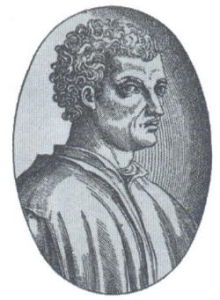
Alberti continued to thrive despite his financial and mental health problems. As Alberti biographer Anthony Grafton describes it, he kept a close circle of friends with whom he "enjoyed rigorous outdoor exercise, especially mountain climbing" while his diverse range of interests saw him "learning music on his own, without a teacher [and] so well that learned musicians praised him and took his advice".
After graduating from Bologna, Alberti turned his back on a legal career in favor of a "literary" role as secretary to Cardinal Nicholaes Albergati and in the same year (1428) the ban on the Albertis working in Florence was relaxed. (As Gadol explained, "the so-called popular party to which the Medici and the Alberti family belonged began to successfully counter the influence of the oligarchical faction headed by the Albizzi family".) Although he was free to return to Florence Alberti still had to contend with familial hostilities. As biographer Anthony Grafton says, Alberti "did his best to ally himself with his relatives in Florence [but] all his efforts, or most of them, were in vain [and he] found himself rejected by his family and beset by critics who carped at everything he did".
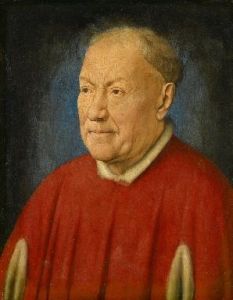
Although biographical details on this period in his life remain sketchy, it is known that in 1432 he travelled to Rome to work for Bishop Biagio Molin as a secretary of the papal chancery and was given the task of writing the biographies of saints and martyrs in a style Gadol described as "elegant 'classical' Latin". Alberti's own interest in art was also blossoming at this time and, according to Grafton, he "took a number of opportunities to paint pictures of events in the martyr's life, and even to interpret them, as if he were already thinking about the ways painters should choose and execute their subjects - a theme that would soon become central to his thought".
Not only would the move to Rome mark the start of a lifetime of employment with various papacy courts, it also saw him take his own holy orders. According to De Marco, Alberti "became an apostolic abbreviator [a secretary in the chancery of the Pope whose role was to "abbreviate" petitions according to established pontifical laws and to draft the minutes of the apostolic letters]. The papal court allowed him to observe closely the writings and classical works, from which he began his most famous treatises, De pictura, De statua and De re aedificatoria".
Despite his high rank, Alberti showed no interest in serving the papacy in a conventional way. As Gadol explains, he "seems to have given no further thought to advancement within the hierarchy of the Church. Once the problem of securing a livelihood was settled, it was his intellectual career that he developed" and he set about working "on humanistic, scientific, and artistic problems which led to him writing a dialogue On the Family [Della famiglia], the first of his major humanistic pieces and a landmark in the history of Italian prose". Gadol adds that "In Alberti's dialogues the ethical ideals of the ancient world are made to foster a distinctively modern outlook: a morality founded upon the idea of work. Virtue has become a matter of action, not of right thinking [and it] arises not out of serene detachment but out of striving, labouring, producing".
Mature Period
In 1434, Alberti joined the papal court of Pope Eugenius IV which allowed him to return to Florence. Once settled in Florence he began to marvel at the City's magnificent new architecture. As Gadol explains once more, "[Filippo] Brunelleschi was just completing his work on the Duomo" and he could also study Brunelleschi's other Florentine buildings which all "had a tremendous impact upon [him] and gave a decisive turn to his [own] development". Alberti was galvanized and pursued a wide range of new creative interests including cartography and experiments with a camera obscura.
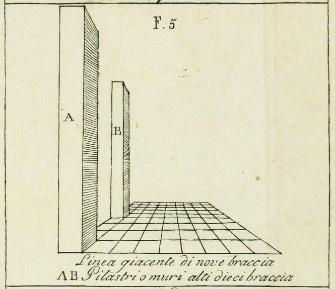
According to Gadol, Alberti became good friends with Brunelleschi, the sculptor Donatello and Leonardo da Vinci (who would elaborate on Alberti's theories of geometry and perspective) and subsequently "threw himself into the artistic renaissance of quattrocento [fifteenth century] Florence". He took up painting and sculpture but his great achievement of this period was his treatises De Pictura (1435). The impact of the treatise on painting and relief work in particular was immediate and immense and provided, as Grafton describes, "the first modern manual for painters [and] the first systematic modern work on the arts".
In Florence Alberti also forged a close friendship with the cosmographer Paolo Toscanelli (who had produced the maps for Columbus's first voyage). The two men collaborated on astronomical projects - both astronomy and geography benefitting from the science of perspective - and Alberti contributed to this field through a small treatise on geography. Gadol suggests that it was probably "the first work of its kind since antiquity [and set] forth the rules for surveying and mapping a land area, in this case the city of Rome, and it was probably as influential as his earlier treatise on painting".
In 1436, Alberti travelled throughout Italy with Pope Eugenius IV before returning to Florence seven years later. He began to associate with the important Florentine artists of the day including Jacopo Bellini and Pisanello. In 1438 he befriended and benefitted from the patronage of Leonello d'Este who employed him at his court in Ferrara as a judge (amongst other things) for an equestrian statue he commissioned in honor of his father (Niccolò III d'Este). It was Leonello who encouraged Alberti to widen his field of expertise and he designed a modest triumphal arch on which the winning equestrian statute would stand.
Leonello also prompted Alberti to revisit the text of Vitruvius, the great architectural theorist of the Roman Emperor Augustus. As Gadol writes, "the monumental theoretical result of his long study of Vitruvius [...] was his De re aedificatoria (The Book of Architecture)" which was not "a restored text of Vitruvius" but rather a "wholly new work, that won him his reputation as the 'Florentine Vitruvius.' It became a bible of Renaissance architecture for it incorporated and made advances upon the engineering knowledge of antiquity, and it grounded the stylistic principles of classical art in a fully developed aesthetic theory of proportionality and harmony". The breadth of Alberti's talents seemed limitless when in 1443 Cardinal Prospero Colonna commissioned him to salvage a sunken ship in Lake Nemi. His attempt failed but led, nevertheless, to a new method of measuring water depth.
During his domestic travels with Pope Eugenius IV, Alberti had closely studied the design of Italy's great buildings; both contemporary and those created by the Romans. His reputation was such that, when Nicholas V became pope in 1447 (the pair were in fact known to each other when Nicholas V was simply Tommaso Parentucelli da Sarzana, a fellow student with Alberti at the University of Bologna) he offered Alberti the post of architectural counsellor. As Gadol wrote, "Together they inaugurated the works of the Renaissance papacy. The various projects Alberti planned and carried out in Rome [such as the reconstruction of St. Peters and the Vatican Palace] gave him the architectural and engineering experience necessary for the comprehensive study of the art of building which he had decided to write, and for the first of his own buildings; the Tempio Malatestiano, which he designed in a bold 'Roman' style for the Lord of Rimini". Erected in 1450, it became his first significant work and launched his career as an architect.
Later Period
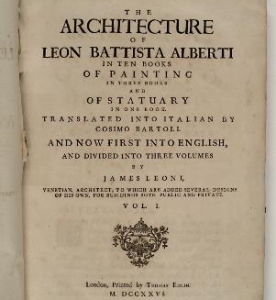
In 1452 (just two years after Alberti designed his first building) Alberti published De re Aedificatoria (On the Art of Building) a series of ten treatise on architecture which helped to define the Renaissance period. For Alberti, architecture and urban planning should be both a mathematically and philosophically precise discipline and his writings outlined the principles that would come to define modern architecture. He learned from the ancient Greeks and Romans and proposed that geometrical harmony should decide all proportions of the architectural structure. As Gadol states, "In architecture he found the mode of plastic expression that suited his artistic genius, and in Giovanni Rucellai and Lodovico Gonzaga he found patrons who encouraged and sponsored him". Both commissioned many works from Alberti including, at the request of Rucellai, the façade of the Santa Maria Novella in 1470.
In addition to his architectural achievements, Alberti continued to pursue other interests. For instance, travel remained an important part of his life and, according to Grafton, he "lived in a fairly regular orbit that took him from Florence to his favorite courts like that of Urbino, where he often spent part of the hot-weather season with his friend, the learned soldier-prince Federigo da Montefeltro". Linguistics was also an important area of his life during the last decades of his life.
Trivia, which was written at the behest of the great Renaissance patron Lorenzo de'Medici, was possibly the first treatise on the rules of Italian grammar and in it Alberti argued that the Tuscan vernacular was as relevant as Latin as a literary idiom.
Alberti also produced a groundbreaking piece on cryptology in which he presented the first known polyalphabetic system of coding, as is credited by some as the first inventor (predating Thomas Jefferson) of the cipher wheel. Although considered a serious man - and who, by becoming a priest, had dedicated his private life to the rules of the church which meant he would never marry or have a family - Alberti had a carefree side to his personality. This was evidenced in a poem he wrote for his beloved pet. According to author Donna Sokol, "Alberti wrote Canis as a eulogy for his dog. Meant to be comical, the florid language of the mock funeral oration praised the dog for his moral integrity and assiduous pursuit of learning".
According to Piedade Ferreira, Alberti, was the embodiment of the Renaissance man: a man who "wasn't a slave of specialization as the modern man would become, but an ever-growing individual whose curiosity could be fed by the contact with many areas of knowledge such as philosophy, mathematics, geometry, astronomy and anatomy". For her, this outlook was not so "very distant from the middle ages' approach to the topic of the body", but with the fundamental difference being that the Renaissance man "embodied [an] approach which anchored knowledge in concrete reality and not only metaphysical exploration". In this respect, the most important of Alberti's later literary works was his 1568 De statua (On Scupture) in which he paid special attention to the role of nature in sculpture.
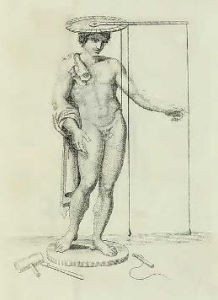
In this book he established the tools and mathematical dimensions required to render the perfect form, not unlike the Ancient Greeks had done centuries before. But Alberti's model included the creation of a revolutionary device, the finitorium. Author Jimmy Stamp described the finitorium thus: "a flat disc inscribed with degrees joined to a movable arm, also inscribed with measurements; from the end hangs a weighted line [that is positioned on the top of the statue]. By rotating the arm and raising or lowering the plumb line, it is technically possible, although surely infuriatingly slow, to map every point on the statue in three-dimensional space relative to its central axis. That data could then be sent to a craftsman who would use it to create an identical copy of the original statue". Grafton adds that by this means Alberti, "transformed the study of the body into a purely empirical discipline" and through his writing "made sculpture a branch of engineering".
Alberti remained intellectually active until his death at the young age of sixty-eight. According to Grafton, "he died a celebrity, renowned for his originality and versatility, which had won him many powerful friends and patrons". The great sixteenth century biographer, Giorgio Vasari described his passing simply as "content and tranquil".
The Legacy of Leon Battista Alberti
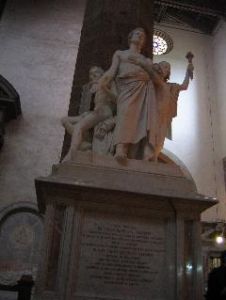
Alberti was at the vanguard of the Early Renaissance and is only matched by Leonardo as the greatest Renaissance polymath. Though he exerted his influence across many fields, Alberti possessed a consistent and homogenous worldview that accorded with mathematical harmony and balance. Through his treatise De Pictura Alberti revolutionized painting by securing the rules on perspective. With its publication he had effectively provided the compositional blueprint for future generations of artists. According to Grafton, "Alberti's [treatise] was as prophetic as it was descriptive [and in] the course of the next half-century, [Andrea] Mantegna and [Andrea del] Castagno, [Giovanni] Bellini and [Sandro] Botticelli would produce works that closely corresponded to his requirements". The laws of De Pictura has been passed down through the centuries and even needed to be first recognized by the radicals who were intent on then breaking them.
Of equal, or perhaps most, importance, however, was the role Alberti played in defining Renaissance architecture, both in his treatise, De re Aedificatoria, and in his own building designs which, according to Gadol, "made the Roman triumphal arch an integral element of Renaissance and hence of European architecture". He not only revived the best elements of Roman design but also reimagined and contemporized them. His influence could be seen almost immediately in the work of Renaissance architects Giacomo Barozzi, Andrea Palladio, and Baldessare Peruzzi. Alberti's signature designs, such as the Santa Maria Novella and the Church of Sant'Andrea, stand today as timeless monuments to his architectural vision. But, as Grafton explains, it is perhaps his treatises that have done most "to spread the taste for a classical style to Northern Europe and to form a language in which Italians and northerners alike could discuss works of art critically".
Influences and Connections

-
![Donatello]() Donatello
Donatello -
![Filippo Brunelleschi]() Filippo Brunelleschi
Filippo Brunelleschi - Vitruvius
- Jacopo Bellini
- Pisanello
- Paolo Toscanelli
- Leonello d'Este
- Ludovico Gonzaga
- Pope Eugenius IV
-
![Gothic Art and Architecture]() Gothic Art and Architecture
Gothic Art and Architecture -
![Romanesque Art]() Romanesque Art
Romanesque Art - Ancient Greek art
- Humanism
- Roman art
-
![Leonardo da Vinci]() Leonardo da Vinci
Leonardo da Vinci -
![Piero della Francesca]() Piero della Francesca
Piero della Francesca - Giacomo Barozzi
- Andrea Palladio
- Baldessare Peruzzi
- Giovanni Rucellai
- Cristoforo Landiono
- Sigismondo Malatesta
- Federigo da Montefeltro
- Angelo Poliziano
-
![Renaissance]() Renaissance
Renaissance - Humanism
Useful Resources on Leon Battista Alberti
- Leon Battista AlbertiBy Joan Kelly- Gadol
- Leon Battista Alberti: Universal Man of the Early RenaissanceOur PickBy Joan Gadol
- On PaintingOur PickBy Leon Battista Alberti
- On SculptureOur PickBy Leon Battista Alberti
- On the Art of Building in Ten BooksOur PickBy Leon Battista Alberti
- The Family in Renaissance FlorenceBy Leon Battista Alberti
 Ask The Art Story AI
Ask The Art Story AI